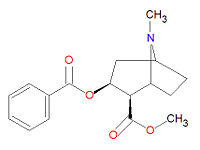Cocaine: Difference between revisions
imported>David E. Volk m (image size) |
imported>David E. Volk m (→External link) |
||
| Line 15: | Line 15: | ||
== External link == | == External link == | ||
* {{DailyMed}} | |||
* {{MedMaster}} | |||
* {{DrugBank}} | |||
Revision as of 12:15, 5 March 2008
'Cocaine or benzoylmethyl ecgonine (IUPAC name methyl (2R,3S)-3-(benzoyloxy)-8-methyl-8-azabicyclo[3.2.1]octane-2-carboxylate) is an organic chemical compound that belongs to the alkaloid category. Its chemical formula is C17H21NO4. Cocaine is a colorless or white crystalline substance. It is primarily extracted from coca plant, largely grown in South America.
Cocaine is primarily used recreationally for its stimulating and euphoric effects on human body. Due to its abuse, the possession, production and distribution of cocaine has been declared illegal by most countries. In the United States, it is classified by the Controlled Substance Act as a Schedule II substance, allowing only limited medical use. Along with heroin and methamphetamine, cocaine is often considered a "hard drug", being much more physically addictive and harmful than a so-called "soft drug" like marijuana. Despite harsh penal codes against the consumption, production, and distribution of the drug, a black market is still flourishing. Street names for cocaine include coke, snow, and blow, among others.
Pharmacology
The majority of cocaine's effects are due to increasing monoamine levels by binding to serotonin (5-HT), norepinephrine (NE), and dopamine (DA) transporters. This blockade prevents the reuptake of neurotransmitters, thus increasing the amount available at the synapse to bind to the post synaptic cell. In contrast to amphetamine, a similar psychomotor stimulant, cocaine only blocks reuptake and does not stimulate DA release.[1] Cocaine's rewarding effects come primarily from increased activity in the mesolimbic dopamine pathway.[2] The three most common routes of administration for cocaine are intravenous, smoked and intranasal. All three routes appear to exert the same phamacological effect, and differ only in the speed of entrance into the brain.[3]
Cocaine has an anesthetic effect by inhibiting voltage-gated sodium (Na+) channels in nerve cells. These channels are essential in generating action potentials, and their blockage prevents nerves from transmitting information. Topical anesthetics have been developed from cocaine's structure to take advantage of this particular property.
References
- ↑ Gold LH, Geyer MA, Koob GF (1989). "Neurochemical mechanisms involved in behavioral effects of amphetamines and related designer drugs". NIDA Res. Monogr. 94: 101–26. PMID 2514360. [e]
- ↑ Kuhar MJ, Ritz MC, Boja JW (1991). "The dopamine hypothesis of the reinforcing properties of cocaine". Trends Neurosci. 14 (7): 299–302. PMID 1719677.
- ↑ Volkow ND, Wang GJ, Fischman MW, et al (2000). "Effects of route of administration on cocaine induced dopamine transporter blockade in the human brain". Life Sci. 67 (12): 1507–15. PMID 10983846. [e]
External link
- Cocaine - FDA approved drug information (drug label) from DailyMed (U.S. National Library of Medicine).
- Template:MedMaster
- Template:DrugBank
